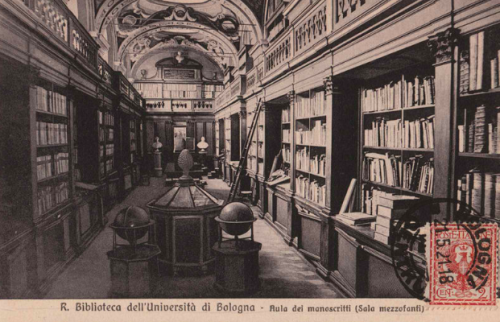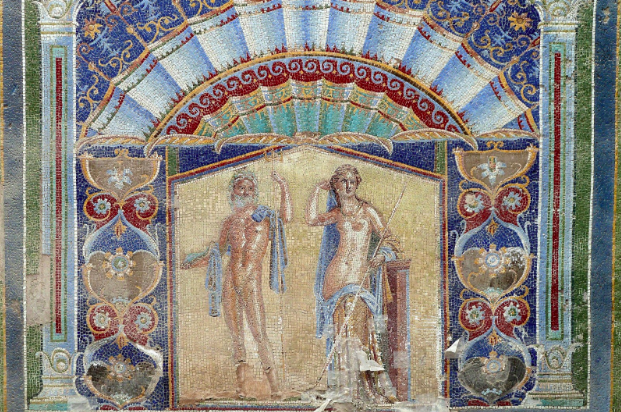When I started to learn Latin, I saw it everywhere. Location played a big role in this — Latin seems woven into the regional character of Italy, where I undertook a summer course in the language in a three-week intensive program at the University of Bologna. Bologna was sweltering, the streets in the center of the city polished until they were slick. Bologna la rossa, the red city: for its red-tinted buildings, or maybe its political persuasions. Bologna, la grossa, the fat city: for its heavy diet. Practically every architectural detail seems to include a Latin word, sometimes rubbed away to the point of obscurity or riddled with confusing acronyms, but there nonetheless. Mass is held in Latin despite the Vatican having begun vernacular mass in the 1960s; drawings and sculptures of Jesus are strung with “INRI” in a hard, lined font [*1]. Because it is a heavily inflected language, Latin is perfect for concise sayings: In stores and restaurants, gelaterias and cafes, I watched people greet each other with “Salve!”, a word just a step away from its Latin equivalent. In this modern rendition the “v” is harder and fricative, while in the Latin it is an open-mouthed sound, like the lighter English “w”. For all these observations, to say that Latin is a ‘dead’ language seemed like an odd statement; I doubted its status as ‘dead’ because I read Latin all around me. Not quite dead and definitely not spoken, Latin seemed to be left in a strange and somewhat artificially constructed posture through decades of study and preservation outside of oral communication. This grey area brought about a host of unanswered questions about language and its messier histories.
When I mentioned to friends and family that I was going to take an introduction to Latin course, I received a variety of responses. This series of reactions surprised me given that I thought of Latin as an interesting but fairly innocuous choice of study. For a ‘dead’ language, it seemed like everyone I talked to had something to say on the matter. Some people to whom I spoke didn’t seem to see “the point” (who among us has not had to defend our choice of study against such pragmatism before?). Others groaned and told me of their school days when they were subjected to paradigms and cases. My grandmother ended an email with amo amas amat amamus amatis amant. Flatmates that I met upon arriving to Bologna asked me why I wasn’t learning Italian, to which I had no good answer. Between all these conversations, I determined two key things: 1) that maybe I should have been learning Italian and 2) that, curiously enough, a so-called dead language was capable of stirring mass opinion even from the grave.
An observation: some people call Latin an ancient language while others call it a dead language. Such inconsistency in title applies to many languages that are ancient and/or dead. The linguistic definition of a dead language is a language that is no longer in spoken use, while an ancient language is defined as a language spoken in ancient era(s). However, to me, a dead language and an ancient language are entirely different beasts. A ‘dead’ language is defined by non-existence alone, while an ‘ancient’ language sounds perhaps like it, too, would involve some degree of non-existence — but this is not its sole defining trait. Despite its apparent classification as obsolete, people sometimes dress in robes, impersonate Julius Cesar, and make-believe that Latin remains well and alive. Why are these words for embodied living things used to describe a non-material phenomenon like Latin? Something is lost here with this nominal laziness: perhaps an emphasis on languages’ ambiguities and nuances that extend beyond the realm of living things.
Despite my newfound appreciation for Latin, this essay is no advertisement for the language. Latin has been around long enough that its reputation precedes it. Learning Latin, by popular narrative in recent history, promises access to the grandeur of the ancient world, an aura of academic rigor, ad infinitum (nauseum?) [*2]. For most of its modern history, knowledge of Latin was a shibboleth of sorts, indicating access to certain socio-economic groups. It is no false accusation that Latin has long been the language of the intellectual elite for longer than it was a vernacular, a language of the people. In fact, even renowned classicist Anne Carson, often noted for her brevity in interviews, said that when offered the choice between typing courses and Latin courses in school, she chose Latin because “it seemed the article of an educated gentlemen.” [*3] Such markers of class distinction badger the history of Latin language learning.

In contrast to the modern fate of the Latin language, there are scores of languages that have been brought to the point of extinction–a step beyond mere death, it would seem. By and large, such languages are the casualties of colonialism, imperialism, and contemporary globalization. Since 1960, a language family dies roughly every four months [*4]. Particularly, hosts of indigenous languages have been lost [*5]. Latin has suffered no such fate — in fact, one could argue that its transition from spoken vernacular to the language of the intellectual elite means that its cultural cache continues to rise, even as people with an understanding of Latin have shrunk in number. Ancient Rome, considered as among the ‘birthplaces’ of Western society, loses little significance with time, particularly in academic circles, despite what some classics departments may bemoan [*6]. The pursuit of modern-day Latin preservation often rings like a quest, or perhaps even a crusade, harnessing rhetoric like “to keep Latin alive” [emphasis added] [*7]. Clinging to major works like the Aeneid seem to be the end goal of such groups, while few advocate for a return to Roman-style graffiti. Efforts at language preservation are slanted, bearing cultural baggage that stands outside of a language’s individual beauty and which complicates the issue of study.
After learning some of these facets of Latin — its cultural stature, its organizational structure created mostly by German grammarians in the 18th century, its conciseness and beauty — I wonder how to proceed. Such questions are at the heart of the larger disciplines of language and history: Why learn something that isn’t part of daily transactions, at least not on any conscious level? There are plenty of Latinate words and occasional idioms in the English language, but knowledge of Latin is not needed to harness them. Can I justify personal investment in a language so deeply embedded in Western academic elitism while other languages rapidly perish? Is interest in the topic sufficient justification for the pursuit of its study? Does that make up for a cultural shortcoming that is worth repairing? The answers to these questions may impact approaches to classical curricula, including that of Bard College Berlin’s Plato core course. This course, as with any course that revolves around parts of the Western ‘canon,’ is situated in the midst of these tensions between historical beauty and a haphazard political, contemporary reality.
I hold open the pink and purple copy of a learner’s guide to Catallus’ poetry, Il Foedus Amoroso di Catullo e Degli Elegiaci, given to me by the ‘host mother’ of a family with which a friend of mine lived for a year. We had gone to visit their country home outside of Parma where they talked about the house during occupied Italy of World War II, travelling men who teach locals how to make salami, and the heat outside, among other things. The host mom took me upstairs to a bedroom that was colder than the rest of the house and lined with dark wood. She reached into the bookshelf nestled in the corner, saying how her mom was a high school classics teacher, and opened the closet to reveal a collection of books, in Italian, on learning Latin and Greek. She offered me this book. I cannot read the Italian commentary.
To read an author in their own language from over 2000 years ago is a beautiful and somewhat uncanny experience. However, as the history of language preservation reveals in its Western lopsidedness, we might first be required to untangle a long and strange meta-literature. In other words, reading in another language requires firstly an inspection of its political conditions, by what means it was brought into your hands. In writing, it seems like a grounded reader must account for not only when a text was written, but should account as well for the time that has passed between the writing and their reading of the text.
I flip the book open to Catullus LXX: “In vento et rapida scribere oportet aqua.” He is writing about the things women say to their lovers, and how such things should be written in wind and quick water. In reading this now, I wonder what Catullus thought to be the fate of his own words, if when he wrote this on parchment he thought again that there must be reason to write on something other than wind and quick water.
______
Notes:
[*1] INRI are Latin initials that stand for Iēsus Nazarēnus, Rēx Iūdaeōrum (John 19:19). In English this reads as “Jesus the Nazarene, King of the Jews”
[*2] Often used in English writing as well, these two Latin idioms mean, respectively: “to the point of infinity” and “to the point of nausea.”
[*3] D’Agata, John, and Anne Carson. “A ___ With Anne Carson.” The Iowa Review, vol. 27, no. 2, 1997.
[*4] Thurman, Judith. “A Loss for Words.” The New Yorker, 30 Mar. 2015.
[*5] Woodbury, Anthony. “Endangered Languages .” Linguistic Society of America, 2012, www.linguisticsociety.org/content/endangered-languages.
[*6] Jenkyns, Richard. “Latin’s Place in Modern Society.” Oxford Today, University of Oxford, 22 Apr. 2013, www.oxfordtoday.ox.ac.uk/features/latin%E2%80%99s-place-modern-society.
[*7] “Modern Latin Speakers — Keeping a Dead Language Alive.” The Translation Company, thetranslationcompany.com/news/blog/language-news/latin/modern-latin-speakers-keeping-language-alive/.

